 When I was a kid, I’d beg and cry every morning not to be sent to school.
When I was a kid, I’d beg and cry every morning not to be sent to school.
It was a small suburban K-6 with perfectly nice teachers. To any outsider, it would look great. But to me, it felt like being trapped in a bewildering, blinding space, where people put me on the spot with indecipherable demands. There were screeching bells and lights and shouts and confusing expectations at every turn. I wanted to run and hide. I wanted to be invisible.
My anxiety would start ratcheting up on the morning bus. It was as if my heart was trying to burst out of my chest. Eventually I confided this to my grandmother, worried I had some terrible ailment. She only rolled her eyes and said, “Pshaw! It’s just a few butterflies.”
Why did she call them butterflies? It felt far beyond “butterflies.” It felt more like big dusty worry-moths, flapping inside my chest.

The recollection of these childhood sensory struggles—and how frustrating it was when loving, well-meaning adults brushed them off and dismissed them—are what brought Invisible Isabel into being.
Isabel has a brain that works just a bit differently. She is sweet, sensitive, gentle, and anxious. She tries so hard to do all the right things, to learn to withstand all the hubbub and hullaballoo of school and home life–what she calls the Too-Muchness.
More than anything, Isabel wants to befriend other girls. She yearns for connection, but doesn’t know how to go about it. She is just a bit too different, too “off.” And her peers treat her like she is invisible.
It’s a fairly common phenomenon for neurodivergent, socially awkward, or autistic girls to try and attach themselves to a “Queen Bee” girl. This way, they feel they will have a protector, a captain to guide them through the tricky social waters. And so, Isabel tries so very hard to befriend the new popular Monica. But Monica is a sly bully, with problems of her own.
In this story, I also wanted to address, and honor, the mind-body connection. How our worries manifest in our bodies. The difference between the discomfort we may feel from psychological versus physiological pain, and how it’s often almost impossible to distinguish between the two. Especially for the young. Isabel contends with both kinds of pain in this story.
I know there are many, many little Isabels out there. I want to encourage them and show them love. I want them to see themselves validated and reflected and honored. Sensitive, anxious young kids need gentle stories of redemption and resilience written just for them.
And there are far too many anxious kids out there, these days, grappling with these sorts of invisible feelings and issues. Even before Covid, the CDC estimated that anxiety was affecting 9.4 percent of children between ages 3 and 17 (approximately 5.8 million kids). That number is surely much higher now, five years later, post-Covid. And anxiety disorders increase with age: they now affect 31.9 percent of teens, according to the ADAA.
And please allow me to also mention that there are still far too many underdiagnosed autistic girls out there, invisible, and grossly misunderstood.
So, this is a little story to help our anxious young friends feel more ‘seen.’ And to see themselves, compassionately and authentically reflected. It is a story to help other young friends realize that the surface of someone may not reflect who they really are inside, or how much potential for goodness and fun and friendship they may have inside them. Even if they seem a little ‘off.’
We all have different reasons for reading. For me, I’m always in search of that “aha” moment of recognizing my own quirky inner truth in a story. I love it when, thanks to words on a page, I’m allowed inside another human mind, and am happily shocked by some significant point of communion.
I am grateful for all of your compassionate and kind hearts, dear readers.



“I really enjoy reading your blog. Your writing style is engaging, and you have a knack for making even complex topics interesting. I always look forward to seeing what you post next. It’s a great resource.”ailinkboost
“I’m consistently impressed with the quality of your blog. The information is always well-researched and presented in a really accessible way. I find myself learning something new every time I visit. Keep up the fantastic work!” ailinkboost